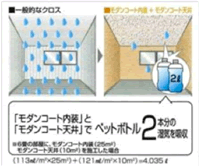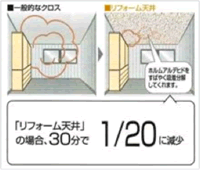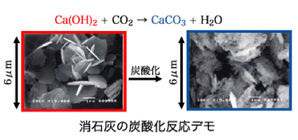- 壁職人.comホーム
- > 壁材情報
- >
珪藻土
Diatomaceous earthmaterials
Diatomaceous earth breathing

Diatomaceous earth absorbs the moisture of about 1.5 to 2 PET bottles (2 L) when diatomaceous earth building material is applied to walls and ceilings of six places in the humidity control function unique to diatomaceous earth.
Diatomaceous earth has numerous pores with a diameter of about 2 to 10 nanometers (1 nanometer is a billionth of a meter) (the more pores there are, the more the moisture absorbing and releasing function is large and the ability to adjust the humidity is high) It exhibits the effect of preventing moisture condensation and moisture damage by moisture. (It is said that 1 g of diatom earth has a surface area of half tennis court [250 m 2] The area of one standard tennis court is 500 m 2 [151.5 tsubo].)

Since it is autonomous moisture absorption and release by the function of pores, the humidity control is semi-permanent, and it is also an ecological air conditioning that does not require energy. Humidity control function is demonstrated by taking moisture into this small hole. If it is hot and humid in the summer, it absorbs the humidity, and if it is dry in the winter, it releases moisture and adjusts the humidity.
Reduction of formaldehyde
Lime has a very high adsorption / decomposition ability of formaldehyde and is alkaline so it has a strong property against molds. Recently, the goodness of lime has begun to be reconfirmed little by little, but in the past the household wall was a plastered wall made from lime. The plastered wall is now about the wall of a castle or temple. The white wall of the outer wall is plaster.


Stucco as a raw material using the lime and those using lime as a solidification material among diatomaceous earth building materials can obtain the effect of adsorbing and decomposing formaldehyde. There is also a diatomaceous earth building material which has become highly functional by adding formaldehyde adsorption / decomposing agent to diatomaceous earth building material which does not use lime as a solidifying material.
CO2 reduction

Lime as the main raw material for plastics is a cement hardening which is hardened by hydrated lime and carbonation (calcium carbonate) by absorption of CO2 in the air against cement / gypsum etc. which reacts with water and solidifies. In other words, lime sucks CO 2 and reduces it. By using plaster and diatomaceous earth building materials containing lime without using vinyl cloth for walls and ceiling materials, it is possible to reduce CO2 which is the cause of global warming.
Types of diatomaceous earth
"There are about 80 diatomaceous earth producing places in Japan. In famous places such as Hokkaido, Akita, Ishikawa, Shimane, Okayama, Oita etc. There are mining around the world such as the United States, Canada, Germany, France etc in the world. Because it is a natural thing, even if it says diatomite altogether, depending on the type of diatom, upper layer part, and lower part extracted from PH, it can range from weakly acidic to strongly alkaline. "
Currently, "diatomaceous earth products" on the market have types of diatomaceous earth ranging from 50 thousand to 100 thousand types, which can be roughly divided into "naturally dried products", "calcined products", " It is divided into three types.
| Natural dry product | Containing impurities as it is naturally dried. But the price is cheap. |
|---|---|
| Baked goods | Natural dried products baked at about 800 degrees. |
| Fusing agent added calcined product | Sodium salt and soda ash are added to the natural dry product, and at about 1000 degrees, clogging materials such as impure organic matter and carbon are burned away and it is a high-grade product. It decolorizes to a white color and becomes white diatomaceous earth. |

Soda ash (Na 2 CO 3) · ·
Alkaline substance called sodium carbonate or sodium carbonate. The aqueous solution shows strong alkalinity.

Diatomaceous earth products contained in diatomaceous earth building materials sold in the Hanabishi Industry are …
| Natural dry product | Samejima Corporation product · Yoshino gypsum product Samejima Corporation There are products that use baked goods by color. |
|---|---|
| Baked goods | There are no products in the site selling products |
| Fusing agent added calcined product | Shikoku Chemicals Products · One Wheel Products · Fujiwara Chemical Products · Nippon Kasei Products |
The largest use of refined diatomite is used as a filtering material for drinking water, beer and so on.
Why is diatomite suitable for filtration?
Diatoms have shells in small bodies as small as a few tenths to a few hundredths of 1 mm, and further fine holes (0.1 to 1 μm in diameter) are empty in their shells. This small hole functions as a filter.
For example, it is used for filtration of beer which is used for filtration of beer which has been matured in the final stage of beer production actually in Kirin beer or Suntory etc. Since spent diatomite contains beer yeast and protein, it is reused as an effect of lengthening the soil of dry soil and increasing fattening, as a bark compost for planting, and so on.
So, for what purpose is it being used for purposes other than use as a filter material?
For example …
- ■ As an undercoating material for Wajima coat, a method (softworking method) has been developed and used as a baked powder from the Edo period (ground powder) and mixed in lacquer to make a base.
- ■ Ishikawa production and others are famous for Taeba. Naniwa made from diatomaceous earth is an excellent refractory insulation material, which is not as hot as burning on the outside compared to other materials. Since it radiates far infrared rays from the inner wall, it amplifies far infrared rays of charcoal fire, it has less fuel and there is a feature such as easiness to clean up.
- ■ Nobel inventor invented a stabilized explosive "dynamite" by absorbing nitroglycerin into diatomaceous earth. (Nitroglycerin was used before Nobel was born, but since nitroglycerin itself is a very unstable substance, it was difficult to handle before that)
- ■ The oldest building using diatomite as a building material is famous for "St. Sophia church" in Istanbul, Turkey.
"In Japan, diatomaceous earth as a building material is attracting attention now but how is it actually?
There are 40 to 50 types of plastering wall materials as building materials and there are "Expensive" to "Cheap".
"Diatomaceous earth building material" = "natural material"
Although there are many people who think that it is not possible to solidify with diatomite itself, it is necessary to have what is said to be a "hardening agent" to solidify.Chemical resin glue is used as "solidifying agent" Products are the majority.
Until now, since products have been developed for plaster owner and contractors, many of them contain chemical resin glue so that they can be applied thin (about 2 to 3 mm), so many natural materials It is not the fact that it is not. "
As mentioned above, there is a wide range of diatomaceous earth content of less than 10% to 90% or more in the diatomaceous earth building material from "pin" to "kiri". Although it can not be said unconditionally, in general, the lower the content rate, the more chemical resin glue is used as the solidifying agent, the lower the price is.
Materials used as solidifying agents also vary from lime type, vegetable paste / starch type, chemical resin type, so compare the respective products and select building materials products that you are satisfied with yourself.
Actually, since the manufacturers are voluntarily releasing content rates and content, etc., there are no inspection institutions such as contents rate and contents, JIS regulations etc, so it is an announcement made by the manufacturer to the last.
"So, the higher the content of diatomite, the better it is, which can not be said unequivocally.
The higher the content, the better the humidity control function will be.
Humidity control performance will change depending on the balance and compatibility with other inclusions.
(Depending on the product, the function may not be fully demonstrated due to differences in inclusions, and the original effect of diatomaceous earth may not be obtained.)
As regards the finish, the diatomaceous earth building material is hard and flat like a plaster and it can not be made completely smooth.
In addition, although there were more people who applied construction of diatomaceous earth building materials and other painted walls by themselves, most of the plastering materials as well as diatomaceous earth building materials are plentiful alkaline substances, and when handled with bare hands measures against hand roughness It is important to use it after observing other precautions such as.
(Powerd by Google)